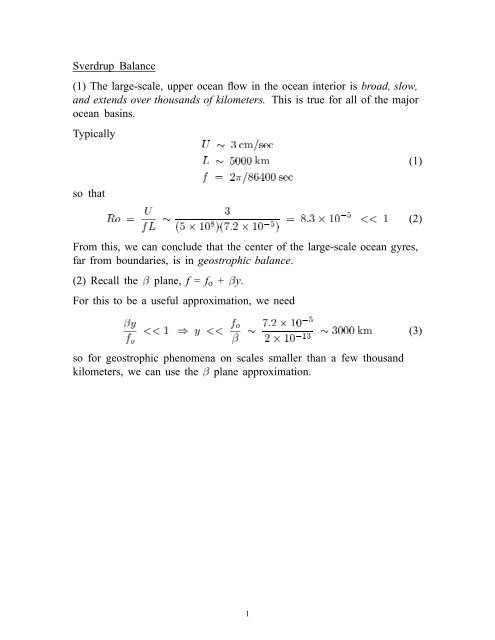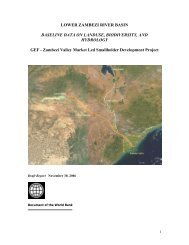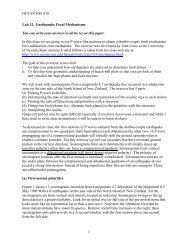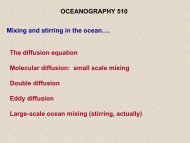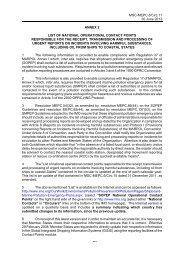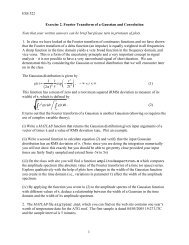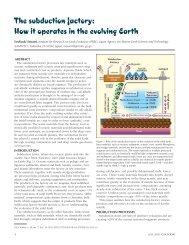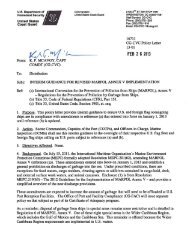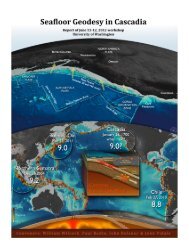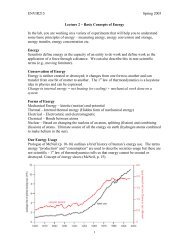Sverdrup Balance (1) The large-scale, upper ocean flow in the ...
Sverdrup Balance (1) The large-scale, upper ocean flow in the ...
Sverdrup Balance (1) The large-scale, upper ocean flow in the ...
You also want an ePaper? Increase the reach of your titles
YUMPU automatically turns print PDFs into web optimized ePapers that Google loves.
<strong>Sverdrup</strong> <strong>Balance</strong>(1) <strong>The</strong> <strong>large</strong>-<strong>scale</strong>, <strong>upper</strong> <strong>ocean</strong> <strong>flow</strong> <strong>in</strong> <strong>the</strong> <strong>ocean</strong> <strong>in</strong>terior is broad, slow,and extends over thousands of kilometers. This is true for all of <strong>the</strong> major<strong>ocean</strong> bas<strong>in</strong>s.Typically(1)so thatFrom this, we can conclude that <strong>the</strong> center of <strong>the</strong> <strong>large</strong>-<strong>scale</strong> <strong>ocean</strong> gyres,far from boundaries, is <strong>in</strong> geostrophic balance.(2) Recall <strong>the</strong> plane, f = f o + y.For this to be a useful approximation, we needso for geostrophic phenomena on <strong>scale</strong>s smaller than a few thousandkilometers, we can use <strong>the</strong> plane approximation.(2)(3)1
(3) Geostrophic and Ekman effectsLet u=(u, v) be <strong>the</strong> horizontal velocity, composed of a geostrophic and anEkman part. Thus, u = u g + u e . <strong>The</strong> equations of motion <strong>the</strong>n become(4)This can be separated <strong>in</strong>to Ekman and geostrophic parts. <strong>The</strong> geostrophicpart is(5)<strong>The</strong> Ekman part is(6)<strong>The</strong> first set of equations can be solved for v g <strong>in</strong> terms of w to f<strong>in</strong>d thatThis is a simple vorticity equation for <strong>the</strong> geostrophic, mid-<strong>ocean</strong> <strong>flow</strong>. <strong>The</strong>left side is <strong>the</strong> planetary vorticity; <strong>the</strong> right side is <strong>the</strong> vortex stretch<strong>in</strong>g.This can be <strong>in</strong>tegrated to f<strong>in</strong>d thatwhere V is <strong>the</strong> meridional velocity averaged between <strong>the</strong> surface and z= D and w E is <strong>the</strong> Ekman pump<strong>in</strong>g or suction velocity.. <strong>The</strong> verticalvelocity w is assumed to fall to zero at z = D.(7)(8)2
Us<strong>in</strong>g <strong>the</strong> Ekman equations, and <strong>in</strong>corporat<strong>in</strong>g <strong>the</strong> -plane approximation,it can be shown that (see <strong>the</strong> notes on Ekman pump<strong>in</strong>g and suction)(9)Putt<strong>in</strong>g <strong>the</strong> Ekman and geostrophic parts toge<strong>the</strong>r, we f<strong>in</strong>d that(10)¡ ¡ ¡Thus <strong>the</strong> total meridional transport (left side) is equal to <strong>the</strong> geostrophictransport (first term on right, usually referred to as <strong>the</strong> <strong>Sverdrup</strong> relation)plus Ekman transport (second term on right).Questions:(1) Does this work?(2) Can it be tested?(3) What modifications might be necessary?3


